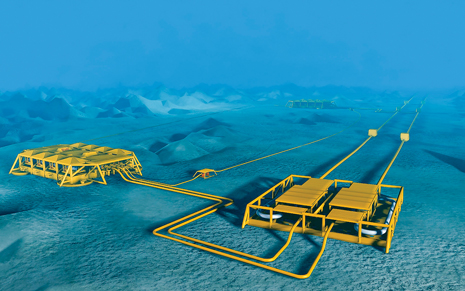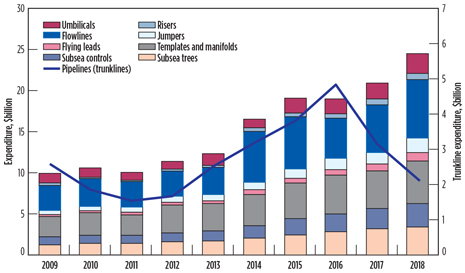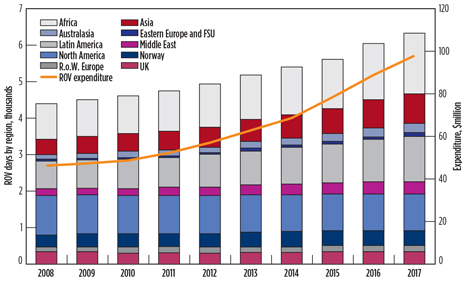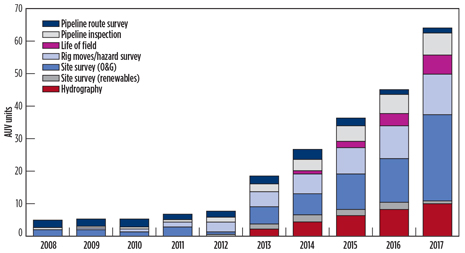Subsea infrastructure growing and moving deeper
Opportunities for subsea infrastructure growth continue, as the technology used to exploit deepwater resources improves, and the environments become more challenging.
A major factor driving subsea activity is the growth of deepwater production. The early shallow-water fields are depleting, forcing operating companies to move into deeper waters (>500-m water depths), where large discoveries can still be made. Deepwater production is concentrated off West Africa and Latin America, and in the Gulf of Mexico. However, new discoveries are being made off East Africa, the eastern Mediterranean and Southeast Asia. Deepwater production is forecast to rise from 10% of global oil output in 2013 to 18% by 2025. This is a substantial increase, considering the impact of unconventional production in North America and continued output in shallow water, particularly offshore the Middle East and Southeast Asia. Douglas-Westwood (DW) predicts deepwater expenditures will grow some 130% over the preceding five-year period, totalling $260 billion, driven by Africa and the Americas, together accounting for 82% of capex. Deepwater E&P activity is driven by a variety of supply-and-demand factors:
Recent, large, natural gas discoveries offshore Tanzania and Mozambique include the Mamba and Prosperidade developments, while discoveries in more mature markets, such as Buckskin and Coronado off the U.S., continue to be made. As production from mature basins onshore, and in shallow water, declines, development of deepwater reserves has become increasingly vital. Robust oil prices support investment in deepwater developments; the sustained increase in oil prices that has occurred over the past few years has increased confidence in the sector, with deepwater projects being viable at $80/bbl and upwards. At the time of writing, both Brent and WTI were trading well above $100/bbl with expectations of long-term stability and growth widespread in the industry. (Editor’s note: In the last several weeks before this issue went to press, oil prices fell into the $80s/bbl range. An extended period below that range could negatively impact some of the assumptions within this article.) DW expects a continued trend toward exploration in ultra-deep waters, in excess of 2,000 m. The world’s deepest platform installation is BW Offshore’s BW Pioneer FPSO in the U.S. Gulf of Mexico (WD, 2,600 m), operational since February 2012. E&P operators take a long-term view of deepwater projects. Following decreases in oil prices, operators typically delay investments, but they are unlikely to cancel them in most cases. Faced with reductions in E&P capex budgets, many of the major international operators have focused, instead, on streamlining support services and procurement, and adjusting portfolios to offer maximum returns for cash invested. INFRASTRUCTURE GROWTHOffshore production involves a significant volume of large infrastructure. Worldwide, the following infrastructure is in operation:
A major drive to maximize production from aging assets is underway, involving large-scale modifications to boost end-of-life production. This, and ongoing platform maintenance, makes maintenance, modifications and operational services an area of growing expenditure, extending to subsea as underwater infrastructure grows. Overall, offshore oil and gas production continues to increase in importance, as growth in energy demand carries on unabated. In almost every global region, DW has observed an expanding infrastructure of subsea hardware and production equipment, as field developments taking advantage of advancing technology go onstream. This relatively recent trend has led to the emergence of a busy inspection and maintenance market, where revenue opportunities have grown steadily, and have some of the most positive forecasts in the oil and gas industry. In DW’s recently published World Subsea Hardware Market Forecast 2014-2018, global subsea hardware capex is forecast to total $117 billion between 2014 and 2018, Fig. 1. This represents growth of more than 80%, compared with the preceding five-year period. Subsea production hardware is expected to attract $57 billion in expenditures, as high-value projects go onstream. The subsea umbilical, riser and flowline market approaches $43 billion, while pipeline spending is forecast at $17 billion.
This vast expenditure will nearly double the size of the existing infrastructure network, below the water surface. With non-productive time and delays being prohibitively costly for operators, the outlook for high-quality subsea inspection, repair and maintenance (IRM) is positive. Growth in subsea infrastructure spending continues trending toward deeper waters. Around 44% of total capex in the next five years will target projects in water depths greater than 1,000 m. A large portion of prominent offshore projects, and the vast majority of the so-called mega-projects with greater than $10 billion of capex, are in deepwater areas. In addition to the established deepwater regions in Brazil, West Africa and the U.S. Gulf of Mexico, the newly discovered offshore gas provinces in East Africa and the eastern Mediterranean are also in water depths greater than 1,000 m. They are expected to provide additional markets that will positively impact IRM expenditures in the future. ROV/AUV UTILIZATION TRENDING UPWARDA large proportion of subsea IRM work is executed by remotely operated vehicles (ROVs). IR&M support typically entails work-class ROV inspection, replacement tasks, cutting operations, hatch operations on subsea structures and valves, and cleaning tasks. Although IRM is the smallest market for work-class ROVs, its operating expenditure-driven nature ensures that it is one of the most secure, in terms of vulnerability to oil price volatility. Driven by the ever-increasing volume of installed subsea hardware described above, demand for IRM is forecast to rise from 5,180 days in 2013 to 6,338 days in 2017 at CAGR 5.2%, Fig. 2. Associated expenditures are forecast to increase from $63 million to $99 million, and the number of dedicated work-class ROVs required will grow from 20 to 25.
Another sector where subsea IRM growth shows promise is related to autonomous underwater vehicle operation (AUV). Used increasingly for deepwater surveys, a range of technological advancements is being developed in this sector. These include riser and spool-piece inspection, pipeline and sealine inspection, and life-of-field inspection. AUVs are proven commercially in pipeline inspection markets, while developments in other areas are taking place at present. AUVs may yet provide a viable option to inspection damage from wave action and impacts, where risers and spool-pieces connect a surface platform to seabed infrastructure. Similarly, life-of-field inspection work and sealine inspection surveys are in the early stages of commercial development. Tests employing AUVs for sealine inspections have been carried out recently and are continuing to be applied to the units in some regions, while life-of-field inspection activity has generaly been delayed until 2015. With the growing infrastructure and subsea pipeline network, we expect to see AUVs gain market share over the coming five-year period, Fig. 3.
IMPLICATIONS OF IRM GROWTHIn addition to increasing markets for underwater vehicles, the growing subsea infrastructure has significant implications for other service sectors of the supply chain, notably for subsea-related vessels that are employed to assist with a wide range of servicing, maintenance and replacement tasks. Vessels are required to support underwater vehicles directly, in addition to transporting equipment and service personnel, and installing additional equipment, where necessary. In analyzing the support vessel markets worldwide, expenditure trends on vessel IRM are particularly prominent in the mature offshore regions, as may be expected. As regions with a high volume of ongoing installations mature, IRM vessel demand will grow accordingly and gain prominence in these newer regions. There are several regions where IRM vessel demand is expected to be highest, as follows. North America. Over the next five years, subsea expenditure in the region will be dominated by deepwater developments, with a number of high-profile projects coming onstream in the U.S. Gulf of Mexico. While projects, including Chevron’s Jack/St. Malo, LLOG’s Delta House and Anadarko’s Lucius, are coming online this year, North America will also remain one of the world’s most significant regions for subsea vessel demand and expenditure, due to the IRM needs of the massive installed base of offshore infrastructure. Total expenditure on IRM in North America is expected to be $12.5 billion from 2013-2017, making North America the largest IRM market. UK. The UK is one of the most mature offshore regions, with a high proportion of shallow-water production and field developments using subsea trees. Often, these are tied back to existing infrastructure to reduce capital spending on platforms. This, in turn, impacts on topsides and subsea inspection and maintenance equipment. Shallow-water developments will continue to dominate UK subsea expenditures, and with the extensive infrastructure, vessel demand is driven primarily by IRM activities. Over the forecast five-year period, expenditure and vessel demand for both IRM and field development will account for over 45% of the total (with construction and drilling support comprising the remainder). The UK is expected to spend $3.2 billion on IRM from 2013-2017. Norway. This is a mature offshore region and, like the UK, has a significant proportion of shallow-water production, while deepwater activity remains limited but growing. Demand for vessel services is required primarily for those projects in water depths of 250-500 m, although this will migrate toward deeper water in the longer term. In DW’s total vessel spending forecast, the market is expected to decline slightly, due largely to a lack of visibility of pipeline construction projects in the out years. Vessel demand is forecast to peak in 2016, with an anticipated increase in pipeline activity that year. Overall activity in the next five years is expected to be driven by IRM, as field developments and pipeline activity fluctuate. Norwegian expediutres on IRM are expected to be $2.5 billion from 2013-2017. Rest of Western Europe. The rest of Western Europe is also a mature region, but with mostly shallow water production and little deepwater activity, to date. However, there are potential deepwater gas developments in the waters of the eastern Mediterranean. Apart from those, the maturity of the infrastructure in the region means that IRM plays a significant role in vessel demand here, also, with a mature fleet of service providers. The Rest of Western Europe is expected to spend $1.7 billion on IRM from 2013-2017. Australia and Asia. Australia’s offshore oil and gas reserves are found in the Bonaparte, Browse and Carnarvon basins off the west coast, as well as in the Otway, Bass and Gippsland basins off the southern coast. Large shallow-water gas developments will continue to dominate subsea activities, at least until 2016. There are no visible projects in 2017, but major projects are due to come onstream later. Field development will account for the largest demand in the region. However, IRM is a significant contributor also, with the second highest vessel demand share. The total IRM expenditure in Australia and Asia from 2013-2017 is expected to be $1.4 billion, making it the smallest market of the regions covered. CAPEX CUT-BACKS THREATEN NEAR-TERM GROWTHChallenging the growth story in subsea infrastructure and associated services is the prevailing uncertainty for future E&P companies’ capital expenditure budgets. Reductions announced by many of the major international operators in 2014 are expected to threaten projects with higher capital outlay, including those in deepwater and conditions otherwise suitable for subsea field development. Another element constraining budgets is the unabated rise in oil industry cost inflation. In fact, most surveys show that the “double digit” cost inflation seen in the last cycle has returned post-2009. Costs are rising at a much higher rate than free cash flow for operators. This is not a sustainable situation for the E&P firms. In fact, a Goldman Sachs study highlighted the impact very clearly, showing that the returns for oil majors, measured in terms of cash return on cash invested, are now at their lowest levels since 1999, when the oil price fell to under $10/bbl. Reductions are expected to slow growth in upstream capex in the short-term, extending to 2015. However, subsea IRM retains a positive outlook, servicing an expanding network of subsea infrastructure; albeit expanding at a lower pace in the near-term than would have been the case otherwise. However, as the present situation in the Middle East proves, there is always potential for oil prices to again rise and further drive the move into deep waters, along with further growth in the associated capital expenditure. POSITIVE SUBSEA IRM OUTLOOKSubsea developments will continue to account for an ever-increasing share of global offshore activity. The technologies deployed are unlocking reserves that previously would have been difficult or impossible to access, and the sector has become a sizable opportunity for the oilfield service and equipment industry. The outlook for the subsea IRM market shows growth potential well beyond a five-year forecast, particularly in the longer-term, as Arctic resources are targeted off Canada, Norway and Russia. This is positive news for IRM providers, who continue to gain importance in the global industry. NOTE The 4th edition of DW’s World Subsea Hardware Market Forecast 2014-2018 details specific subsea hardware trends by region and component, supported by analysis, insight and industry consultation. http://www.douglas-westwood.com/shop/shop-infopage.php?longref=1373 Established in 1990, Douglas-Westwood is a leading provider of market research and consulting services to the energy industry, worldwide. It has completed 1,000 projects for clients in more than 70 different countries and in some 250 niche energy segments. Its clients range from the oil and gas majors and their contractors, to financial houses and governments. DW is an independent organization, and our research is supported by proprietary data, insight and knowledge. This international reach is backed up by one of the largest sector-focused teams, with offices in the Americas, Europe and Asia. www.douglas-westwood.com |
- Subsea technology- Corrosion monitoring: From failure to success (February 2024)
- Prices and governmental policies combine to stymie Canadian upstream growth (February 2024)
- U.S. producing gas wells increase despite low prices (February 2024)
- U.S. drilling: More of the same expected (February 2024)
- U.S. oil and natural gas production hits record highs (February 2024)
- Mixed outlook for activity on the UK Continental Shelf (December 2023)






